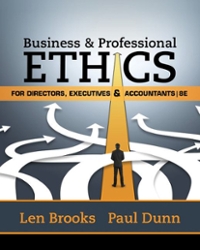The Kardell paper mill was established at the turn of the century on the Cherokee River in
Question:
The Kardell paper mill was established at the turn of the century on the Cherokee River in southeastern Ontario by the Kardell family. By 1985, the Kardell Paper Co. had outgrown its original mill and had encompassed several facilities in different locations, generating total revenues of \($1.7\) billion per year. The original mill continued to function and was the firm’s largest profit center. The Kardell family no longer owned shares in the firm, which had become a publicly traded company whose shares were widely held.
Kardell Paper Co. was a firm with a record of reporting good profits and had a policy of paying generous bonuses to the chief executive officer and other senior executives.
Kardell’s original mill was located near Riverside, a community of 22,000. Riverside was largely dependent on the mill, which employed 500 people. The plant, while somewhat outdated, was still reasonably efficient and profitable. It was not designed with environmental protection in mind, and the waste water that discharged into the Cherokee River was screened only to remove the level of contaminants required by provincial regulation. There were other industrial plants upstream from the Kardell plant.
The residential community of Riverside, five miles downstream from the plant, was home to many of the Kardell plant’s management, including Jack Green, a young engineer with two children, ages one and four.
Jack, who was assistant production manager at the Kardell plant, was sensitive to environmental issues and made a point of keeping up on the latest paper mill technology.
Jack monitored activity at the plant’s laboratory, which in 1985 employed a summer student to conduct tests on water quality in the Cherokee River immediately downstream from the plant.
These tests were taken across the entire width of the river. The tests conducted nearest the plant’s discharge pipe showed high readings of an industrial chemical called sonox. Farther away from the plant and on the opposite shore of the river, the water showed only small trace amounts of sonox. Sonox was used in the manufacture of a line of bleached kraft paper that Kardell had begun to make at its plant in recent years.
The student researcher discovered that the plant lab was not including the high readings of sonox in its monthly reports to management, so the student showed the complete records to Jack. In the summer of 1985, Jack made a report to the CEO with a recommendation that in-depth studies be conducted into the situation and its implications for public health and longterm effects on the ecology.
In recommending that Kardell carry out an “environmental audit” of its operations, Jack pointed out that local doctors in Riverside had been expressing concern over what appeared to be an unusually high rate of miscarriages and respiratory disorders in the community. Jack told the CEO there were data suggesting a possible link between health problems and sonox but no definite proof. Medical research into sonox’s possible effects on humans was continuing.
In bringing his concerns to the CEO’s attention, Jack offered as a possible solution the option of Kardell adopting a new processing technology which used recycling techniques for waste water. This technology, already employed by a handful of plants in Europe, enabled a plant to operate in a “closed cycle” that not only protected the environment but reclaimed waste material, which was then sold to chemical producers.
Thus, in the long term the new process was cost-effective. In the short run, however, refitting the existing Kardell plant to incorporate the new technology would cost about \($70\) million, and, during the retrofit, the plant would have to operate at reduced capacity levels for about a year and possibly be closed down altogether for an additional year to make the change-over.
The Response Kardell’s traditional response to environmental concerns was reactive. The company took its cues from the regulatory climate. That is, the provincial environment ministry would apply control orders on the plant as new limits on emissions of various compounds came into effect, and Kardell would then comply with these orders.
In raising his concerns in 1985, Jack pointed out that the Ministry of Environment, responding to the serious nature of concerns raised by the sonox issue, was considering internal proposals from its staff that additional research be done into the sources and implications of sonox.
Given the early stage of work in this area, Jack could offer no indication of when, if ever, the Ministry would enact new regulations to do with sonox. He argued, however, that the ground rules might change, as they had with previous compounds, and that Kardell should give some thought to the worst-case scenario of how the sonox issue could turn out down the road........
Questions:-
1. Who are the stakeholders involved, and what are their interests?
2. Which stakeholders and interests are the most important? Why?
3. What was wrong with the quality of the board of directors’ debate?
4. What is the downside if the right decision is not made? Consider economic factors and also what Jack might do.
Step by Step Answer:

Business And Professional Ethics
ISBN: 9781337514460
8th Edition
Authors: Leonard J Brooks, Paul Dunn





